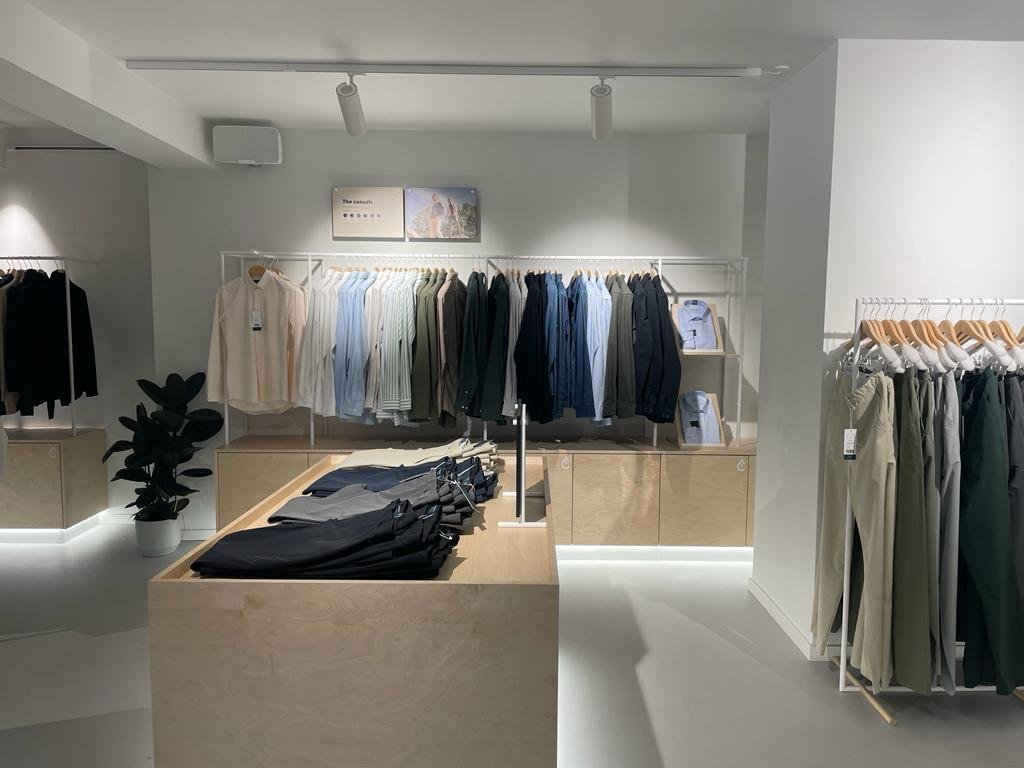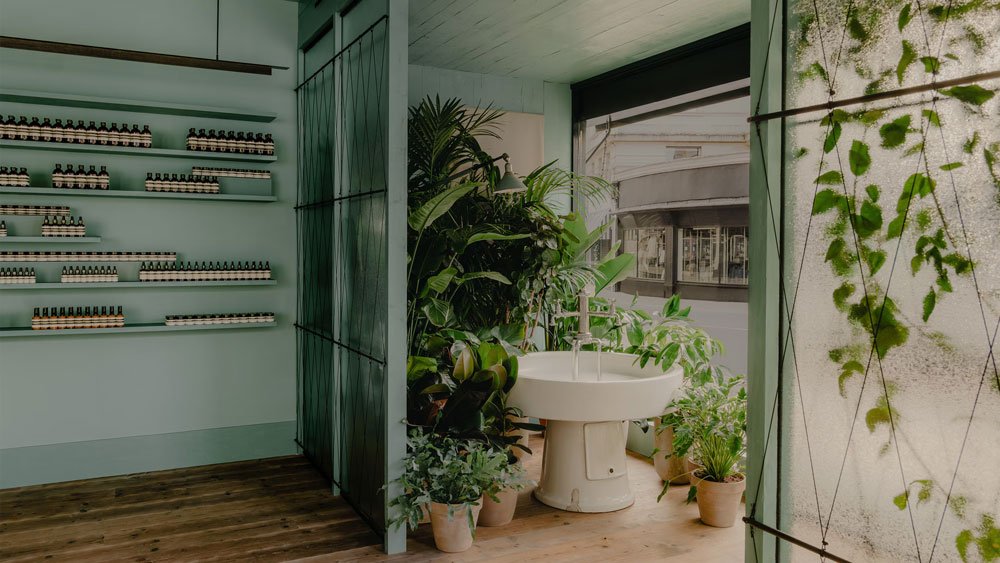INSIGHT
What are the characteristics of British interior design?
Cultural heritage and history
British creativity is admired on a global basis and British interior design, and British designers are recognised throughout the world. Much of the enduring appeal is due in some part to its indefinable quality. For example, Scandinavian design is singular and easily defined. Equally Italian design has a similarly identifiable aesthetic.
Minimalist store design with clean wood finishes at Labfresh, Copenhagen
Extravagant animal print design cues at Dolce & Gabbana Casa Store in Milan, Italy
British design however, is often described as an attitude and a spirit, making its definition much more elusive, whilst similarly, easy to identify.
One of the reasons why British design is so unique and has so much emotional saliency, and global appeal, is that to a large extent it has been shaped and influenced by the fact that we in Britain have so many buildings, particularly in key shopping streets that are listed and already have a distinctive architecture and original features that need to be preserved.
Consequently, many of the identifiable and familiar British interior design codes and cues such as dark oak panelling, wooden floors, natural materials, ceiling beams, texture, and pattern all draw their inspiration from more traditional sources.
Given our creative culture, we have in British design, a particular talent in using these style references, in spaces where we need to preserve these original features, to layer, enrich and reinvent in a way that combines old and new, and explores creative boundaries to create something unique, but which retains the architectural essence of the space and the building.
This approach goes beyond an aesthetic and embraces, culture, history, fashion and music in its various historical influences and manifestations. Irreverence, design innovation and creativity lies at the heart of British design ensuring that it continues to lead and inspire globally, and remain powerful, highly valued and much referenced, and emulated.
God save the queen, by English punk rock band the Sex Pistols. © Andrew Stawarz
Translating the British aesthetic worldwide
There is a huge range of opportunities to interpret ones own brand and design take on the fusion of tradition and innovation and to place oneself at any point of this continuum.
Arguably this very elusiveness is what gives British design its powerful and global cultural appeal. It is not a singular entity but can be expressed in many different ways and aesthetic styles, always remaining fresh, surprising and relevant.
This is why British brands are so well placed to leverage British design as they recognise how eminently exportable and desirable it is for an international audience. For example British brands can easily run the gamut from traditional to modern whilst remaining uniquely, distinctively, and immediately recognisable British.
Indeed this embracing of individualism could be defined as one of the defining characteristics of British interior design, allowing greater freedom to express a brand aesthetic in ways that can become own-able and unique to a brand, and reflecting their product and design point of view and aesthetic.
Caulder Moore inspirational work
The interior design market in the UK generates about £10 billion ($12.5 billion) in industry revenues annually, again, a compelling proof point of the rich variety of world leading talent in this industry.
We, as Caulder Moore, a creative design agency specialising in accessible premium, hospitality, and retail design for a range of international brands, have a particular expertise in creating environments that articulates a brand aesthetic in a way that is uniquely British and allows our clients ability to express their Britishness in a way that fuels not only their domestic business but also elevates their appeal internationally.
For many brands, particularly British brands with a large global footprint, using British design and architectural references helps to establish a sense of place and anchor the brand in the minds of customers in a particular place and time.
British interior design has a rich seam of cultural references to inspire their brand aesthetic, and there are quite a few examples of how we have helped brands to articulate their individual brand worlds.
For Aspinal of London, in their flagship store in Regent Street in London, we created an exuberant expression of a country home, symmetrically dividing the space into individual rooms to create a sense of intimacy and also to create a sense of surprise and individual style for each of the rooms. An eclectic mix of floral patterns, high ceilings, antique furniture, fireplaces, patterned wallpapers, intricate details, decorative elements, and a dramatic staircase combined a sense of English elegance and classic style with delightful discoveries of intimate details. We managed to achieve this in a space that although benefitted from a listed frontage, did not possess any original architectural features in the interior. For a brand with a global retail footprint, predominantly in shopping malls in the Middle and Far East, this created the foundation for the creative approach in translating the essence of this 'English home' globally in spaces which did not necessarily possess any inherently British architectural features.
William Morris wallpaper with a classically inspired chandelier and staircase balcony at Aspinal of London, Regent Street, design by Caulder Moore
Cosy, intimate games room with a dramatic plasterboard ceiling, wooden panels and a bespoke pool table
Wall panel details with a floral wallpaper relief and gold accents at Aspinal of London, Regents Street
Pepe is a brand born not only in London, but specifically in Notting Hill and Portobello, with strong cultural references to the music industry. When they were seeking a new retail concept, it was particularly important, especially in their global markets to reinforce and express this unique heritage, and to employ design elements to amplify this storytelling and unique brand narrative. As an example we used coloured doors to the changing rooms that directly reference the iconic architecture of Notting Hill, and created design features around music references. The resulting concept allowed Pepe to celebrate its authentic roots in a compelling way that resonated with their youthful audience and enriched their brand narrative and experience.
Vintage speaker inspired service counter at Pepe Jeans store
Colourful fitting room doors in Pepe store design referencing Notting Hill London houses design by Caulder Moore
For Thameen, a London based luxury fragrance brand, because of their expanding trade in international markets, it was essential to create a concept that expressed a strong essence of Britishness through the use of timber panelling, and cabinetry which evoked a strong sense of craft, with traditional lighting features, and architectural elements that drew inspiration from traditional frontage in London's iconic shopping streets.
Layering in soft carpets with a modern take on traditional panelled walls
Arched shopfront inspired by traditional facades in London, designed by Caulder Moore
Fusion of the old British style and new
Using design and cultural references can of course be consciously evoked to create a sense of nostalgia in brand storytelling, but it is often a mix of old and new elements combined in a brand relevant way that creates a unique experience and expresses a unique brand world.
The use of innovative technologies alongside traditional elements creates a tension between old and new, which in itself is characteristic of British design. As with beautiful British homes, there is a wonderful sense of layering, an evolving over time, which is intrinsically British, and makes it hard to emulate.
We are also well accomplished at integrating found pieces from across the globe, incorporating international influences for a sense of richness and luxury. There is a tradition of collecting in Britain, whether that is plants, botanicals, or art and absorbing them in a way which feels unforced and effortless.
A wonderful example of the harmonious coexistence of past and present is the Liberty store, a mock Tudor Grade II listed building, built from recycled timber from 2 historic ships, helping to give it its unusual and unique character. The interior blends arts and crafts, inspired by the crafts movement with its rich dark colours and English style.
Liberty shopfront, London
Liberty style by Martin Wood: The story of Liberty's is the story of design
Their collection of ornaments, fabrics, objets d'art from around the world which fed the obsession society had with Japan and the East and affected social change in interior design and fashion to the extent that so that Art Nouveau period in Italy was called the Liberty style.
This is only one example of the global influence of our cultural capital in interior design with industry revenue for interior design activities in the UK is estimated to rise at a CAGR of 3.8% over the five years through 2017-18, reaching £6.4 billion
Layering and eclecticism
This layering, this organic approach to design ensures the creation of unique spaces, evolving over time, adding new elements, and modern materials, to create an eclectic style, a mix of building on the original features in a space, with new decorative elements, and brand led design features that create a sense of a locality.
Increasingly brands are more attuned to respecting the interior style and architecture of the buildings they choose, understanding that a more sustainable approach where they sensitively 'layer' in their brand aesthetic to a space is one that creates more individuality and a stronger sense of localisation.
Often this extends to retaining the existing interior structure in terms of the original rooms and exploring how we can balance visual focal points with the room proportions, customer flow and customer journey.
Often when international brands come to Britain, they understand the importance of layering in design elements that are more recognisably British, with a purposeful nod to attuning their global concept to the location.
For example, Le Labo, which has a highly distinctive brand aesthetic, came to us when they opened their first London store. They wanted us to blend their unique interior design signature into the shop space, and layer in some localised design elements, as a way of communicating that they were not simply imposing their brand aesthetic without consideration of their location.
Le Labo London store designed by Caulder Moore
Aesop is one of the most impressive exponents of, as an international brand, of digging deep to localise their concept to the specific context of a location. For example, their recent opening in Richmond, drew on references from nearby Kew Gardens, with the front of the store operating as a winter garden, copious amounts of greenery and a birds bath inspired basin playing a central role.
Garden inspired Aesop store in Richmond
Quality, craftsmanship and comfort
A feature of British design is not only the use of high-quality materials, but also the creation of bespoke features, that become intrinsically linked and associated with a specific brand.
There is an ease in British design, that whilst often being quirky, characterful and eclectic, is also focussed around comfort, and creating a sense of welcome. It feels somehow not very British to be seen to be trying too hard. Often, those occasions when the desire to create a 'British interior' fall short of the mark is because they feel too perfect and of a piece, rather than demonstrating an innate confidence in mixing different elements, and varied textures and patterns to create something unique with a more personal individual perspective. This was a key focus when we worked with Cath Kidston to refurbish their flagship store in London - a comfortable and inviting space where their patterns and products could be showcased in carefully selected crafted displays, curated and at times whimsical small collections of quirky finds.
Cozy and quirky nooks and crannies in Cath Kidston London store designed by Caulder Moore
Cath Kidston store: refurbishing traditional furniture for displaying product
Personality and individuality
In a world where there is great lamentation about the creep of homogenisation, and the emergence of a sea of sameness, there is a huge value and equity in celebrating individuality in brand storytelling.
It is essential to capture a narrative and encourage interest through layers of surprise and creating a sense of discovery in a space.
The objective is to create memories and moments, experiences that customers remember because they are special and unique, and because they make those customers feel valued.
In each and every collaboration we drill into the brand story, and unique personality to uncover those elements that will influence and shape the creation of a memorable experience and recognisable signature brand aesthetic.
To conclude, although there are certain elements that are seen to characterise British design, the most valuable quality is our ability to confidently mix genres, unearth the rich treasure trove of cultural and historical; reference, and consistently reinvent in order to ensure that the results are surprising, memorable and enduring. For British brands there is an opportunity to find their own unique interpretations, and for international brands operating here, to convince customers that they have taken local influences into account and are sensitively attuned to our cultural codes.
Contact us below to discover more.
















